Optimization of Quartz Sand-Enhanced Coagulation for Sewage Treatment by Response Surface Methodology
Abstract
:1. Introduction
2. Materials and Equipment
3. Single Factor QSEC Test
3.1. Single Factor Test Design
3.2. Results and Discussion of Single-Factor Test
3.2.1. Impact of the Particle of Quartz Sand on QSEC
3.2.2. Impact of Dosage of Quartz Sand on QSEC
3.2.3. Impact of PAC Dosage on QSEC
3.2.4. Impact of CPAM Dosage on QSEC
3.2.5. Impact of Sewage pH on QSEC
3.2.6. Impact of Settling Time on QSEC
4. RSM QSEC Test
4.1. RSM QSEC Test Design
4.2. Results and Discussion of the RSM Experiment
4.2.1. Discussion of RSM Experiment Results
4.2.2. Model Fitting
4.2.3. Response Surface Analysis
4.2.4. Optimal Coagulation Conditions and Model Validation
5. Conclusions
Author Contributions
Funding
Institutional Review Board Statement
Informed Consent Statement
Data Availability Statement
Conflicts of Interest
References
- Wang, W.Y.; Yue, Q.Y.; Li, R.H.; Song, W.; Gao, B.Y.; Shen, X. Investigating coagulation behavior of chitosan with different Al species dual-coagulants in dye wastewater treatment. J. Taiwan Inst Chem. E. 2017, 78, 423–430. [Google Scholar] [CrossRef]
- Li, R.H.; Gao, B.Y.; Guo, K.Y.; Yue, Q.Y.; Zheng, H.L.; Wang, Y. Effects of papermaking sludge-based polymer on coagulation behavior in the disperse and reactive dyes wastewater treatment. Bioresour. Technol. 2017, 240, 59–67. [Google Scholar] [CrossRef] [PubMed]
- Chen, N.; Liu, W.; Huang, J.; Qiu, X. Preparation of octopus-like lignin-grafted cationic polyacrylamide flocculant and its application for water flocculation. Int. J. Biol. Macromol. 2020, 146, 9–17. [Google Scholar] [CrossRef] [PubMed]
- Chi, N.; Liu, J.; Lei, M.; Feng, L. Preparation of amphiphilic cationic polyacrylamide (CPAM) with cationic microblock structure to enhance printing and dyeing sludge dewatering and condition performance. Environ. Sci. Pollut. Res. 2022, 30, 13079–13093. [Google Scholar] [CrossRef] [PubMed]
- Yang, K.; Chen, J.; Yao, C. Cationic polyacrylamide emulsion with ultra-high concentration as a flocculant for paper mill wastewater treatment. BioResources 2020, 15, 3173–3189. [Google Scholar] [CrossRef]
- Fan, Y.; Ma, X.; Dong, X.; Feng, Z.; Dong, Y. Characterisation of floc size, effective density and sedimentation under various flocculation mechanisms. Water Sci. Technol. 2020, 82, 1261–1271. [Google Scholar] [CrossRef] [PubMed]
- Sang, Y.; Lin, A.; Liu, X. Population balance modeling of cationic polyacrylamide (CPAM) induced flocculation process for lignin recovery from the pre-hydrolysis liquor of kraft pulping process. Sep. Purif. Technol. 2019, 221, 152–158. [Google Scholar] [CrossRef]
- Zheng, H.; Sun, Y.; Guo, J.; Li, F.; Fan, W.; Liao, Y.; Guan, Q. Characterization and Evaluation of Dewatering Properties of PADB, a Highly Efficient Cationic Flocculant. Ind. Eng. Chem. Res. 2014, 53, 2572–2582. [Google Scholar] [CrossRef]
- Zhang, Z.; Zheng, H.; Huang, F.; Li, X.; He, S.; Zhao, C. Template Polymerization of a Novel Cationic Polyacrylamide: Sequence Distribution, Characterization, and Flocculation Performance. Ind. Eng. Chem. Res. 2016, 55, 9819–9828. [Google Scholar] [CrossRef]
- Shang, H.; Liu, J.; Zheng, Y.; Wang, L. Synthesis, characterization, and flocculation properties of poly(acrylamide-methacryloxyethyltrimethyl ammonium chloride-methacryloxypropyl-trimethoxy silane). J. Appl. Polym. Sci. 2009, 111, 1594–1599. [Google Scholar] [CrossRef]
- Zheng, H.; Sun, Y.; Zhu, C.; Guo, J.; Zhao, C.; Liao, Y.; Guan, Q. UV-initiated polymerization of hydrophobically associating cationic flocculants: Synthesis, characterization, and dewatering properties. Chem. Eng. J. 2013, 234, 318–326. [Google Scholar] [CrossRef]
- Daifa, M.; Shmoeli, E.; Domb, A.J. Enhanced flocculation activity of polyacrylamide-based flocculant for purification of industrial wastewater. Polym. Adv. Technol. 2019, 30, 2636–2646. [Google Scholar] [CrossRef]
- Fijałkowska, G.; Szewczuk-Karpisz, K.; Wiśniewska, M. Chromium (VI) and lead (II) accumulation at the montmorillonite/aqueous solution interface in the presence of polyacrylamide containing quaternary amine groups. J. Mol. Liq. 2019, 293, 111514. [Google Scholar] [CrossRef]
- Wiśniewska, M.; Chibowski, S.; Urban, T.; Terpiłowski, K. Investigations of chromium (III) oxide removal from the aqueous suspension using the mixed flocculant composed of anionic and cationic polyacrylamides. J. Hazard. Mater. 2019, 368, 378–385. [Google Scholar] [CrossRef] [PubMed]
- Szewczuk-Karpisz, K.; Fijałkowska, G.; Wiśniewska, M.; Wójcik, G. Chromium (VI) reduction and accumulation on the kaolinite surface in the presence of cationic soil flocculant. J. Soils Sediments 2020, 20, 3688–3697. [Google Scholar] [CrossRef]
- Zhang, Z.; Zheng, H.; Sun, Y.; Zhao, C.; Zhou, Y.; Tang, X.; Zhao, C. A combined process of chemical precipitation and flocculation for treating phosphating wastewater. Desalination Water Treat. 2016, 57, 25520–25531. [Google Scholar] [CrossRef]
- Harif, S.; Aboulhassan, M.A.; Bammou, L. Multi-response optimization for color removal from cardboard wastewater using polyaluminum chloride and cationic polyacrylamide. Int. J. Environ. Sci. Technol. 2022, 20, 4281–4292. [Google Scholar] [CrossRef]
- Khan, S.; Zheng, H.; Sun, Q.; Liu, Y.; Li, H.; Ding, W.; Navarro, A. Synthesis and characterization of a novel cationic polyacrylamide-based flocculants to remove Congo red efficiently in acid aqueous environment. J. Mater. Sci. Mater. Electron. 2020, 31, 18832–18843. [Google Scholar] [CrossRef]
- Nourani, M.; Baghdadi, M.; Javan, M.; Bidhendi, G.N. Production of a biodegradable flocculant from cotton and evaluation of its performance in coagulation-flocculation of kaolin clay suspension: Optimization through response surface methodology (RSM). J. Environ. Chem. Eng. 2016, 4, 1996–2003. [Google Scholar] [CrossRef]
- Onukwuli, O.D.; Nnaji, P.C.; Menkiti, M.C.; Anadebe, V.C.; Oke, E.O.; Ude, C.N.; Ude, C.J.; Okafor, N.A. Dual-purpose optimization of dye-polluted wastewater decontamination using bio-coagulants from multiple processing techniques via neural intelligence algorithm and response surface methodology. J. Taiwan Inst. Chem. Eng. 2021, 125, 372–386. [Google Scholar] [CrossRef]
- Rezania, N.; Hasani Zonoozi, M.; Saadatpour, M. Coagulation-flocculation of turbid water using graphene oxide: Simulation through response surface methodology and process characterization. Environ. Sci. Pollut. Res. 2021, 28, 14812–14827. [Google Scholar] [CrossRef] [PubMed]
- Lapointe, M.; Farner, J.M.; Hernandez, L.M.; Tufenkji, N. Understanding and improving microplastic removal during water treatment: Impact of coagulation and flocculation. Environ. Sci. Technol. 2020, 54, 8719–8727. [Google Scholar] [CrossRef] [PubMed]
- Liu, X.; Xu, Q.; Wang, D.; Wu, Y.; Yang, Q.; Liu, Y.; Wang, Q.; Li, X.; Li, H.; Zeng, G.; et al. Unveiling the mechanisms of how cationic polyacrylamide affects short-chain fatty acids accumulation during long-term anaerobic fermentation of waste activated sludge. Water Res. 2019, 155, 142–151. [Google Scholar] [CrossRef] [PubMed]
- Wang, C.; Cai, Q.; Feng, B.; Feng, S.; Tian, C.; Jiang, X.; Wu, X.; Xiao, B. Improving the performance of shipboard rotary drum filters in the removal of cyanobacterial blooms by cationic polyacrylamide flocculation. Sep. Purif. Technol. 2019, 215, 660–669. [Google Scholar] [CrossRef]
- Park, J.B.K.; Meerman, C.; Craggs, R. Continuous low dosing of cationic polyacrylamide (PAM) to enhance algal harvest from a hectare-scale wastewater treatment high rate algal pond. New Zealand J. Bot. 2019, 57, 112–124. [Google Scholar] [CrossRef]
- Tajbakhsh, S.F.; Mohmmadipour, R.; Janani, H. One-pot production of a graft copolymer of cationic starch and cationic polyacrylamide applicable as flocculant for wastewater treatment. J. Macromol. Sci. Part A 2022, 59, 698–710. [Google Scholar] [CrossRef]
- Zhang, Z.; Pan, S.; Huang, F.; Li, X.; Shang, J.; Lai, J.; Liao, Y. Nitrogen and Phosphorus Removal by Activated Sludge Process: A Review. Mini-Rev. Org. Chem. 2017, 14, 99–106. [Google Scholar] [CrossRef]
- Wiśniewska, M.; Fijałkowska, G.; Szewczuk-Karpisz, K.; Urban, T.; Nosal-Wiercińska, A.; Wójcik, G. Comparison of adsorption affinity of anionic and cationic polyacrylamides for montmorillonite surface in the presence of chromium (VI) ions. Adsorption 2019, 25, 41–50. [Google Scholar] [CrossRef]
- Zhou, S.; Bu, X.; Alheshibri, M.; Zhan, H.; Xie, G. Floc structure and dewatering performance of kaolin treated with cationic polyacrylamide degraded by hydrodynamic cavitation. Chem. Eng. Commun. 2022, 209, 798–807. [Google Scholar] [CrossRef]
- Agbovi, H.K.; Wilson, L.D. Flocculation optimization of orthophosphate with FeCl3 and alginate using the Box–Behnken response surface methodology. Ind. Eng. Chem. Res. 2017, 56, 3145–3155. [Google Scholar] [CrossRef]
- Ahmad, T.; Ahmad, K.; Alam, M. Simultaneous modelling of coagulant recovery and reuse by response surface methodology. J. Environ. Manag. 2021, 285, 112139. [Google Scholar] [CrossRef] [PubMed]
- Birjandi, N.; Younesi, H.; Bahramifar, N.; Ghafari, S.; Zinatizadeh, A.A.; Sethupathi, S. Optimization of coagulation-flocculation treatment on paper-recycling wastewater: Application of response surface methodology. J. Environ. Sci. Health Part A 2013, 48, 1573–1582. [Google Scholar] [CrossRef] [PubMed]
- Wang, K.; Mao, Y.; Wang, C.; Ke, Q.; Zhao, M.; Wang, Q. Application of a combined response surface methodology (RSM)-artificial neural network (ANN) for multiple target optimization and prediction in a magnetic coagulation process for secondary effluent from municipal wastewater treatment plants. Environ. Sci. Pollut. Res. 2022, 29, 36075–36087. [Google Scholar] [CrossRef] [PubMed]
- Dbik, A.; El Messaoudi, N.; Bentahar, S.; El Khomri, M.; Lacherai, A.; Faska, N. Optimization of Methylene Blue Adsorption on Agricultural Solid Waste Using Box–Behnken Design (BBD) Combined with Response Surface Methodology (RSM) Modeling. Biointerface Res. Appl. Chem. 2022, 12, 4567–4583. [Google Scholar]
- Ezemagu, I.G.; Ejimofor, M.I.; Menkiti, M.C.; Nwobi-Okoye, C.C. Modeling and optimization of turbidity removal from produced water using response surface methodology and artificial neural network. South Afr. J. Chem. Eng. 2021, 35, 78–88. [Google Scholar] [CrossRef]
- Gökçek, Ö.B.; Özdemir, S. Optimization of the coagulation–flocculation process for slaughterhouse wastewater using response surface methodology. CLEAN–Soil. Air Water 2020, 48, 2000033. [Google Scholar] [CrossRef]
- Heidari, M.; Vosoughi, M.; Sadeghi, H.; Dargahi, A.; Mokhtari, S.A. Degradation of diazinon from aqueous solutions by electro-Fenton process: Effect of operating parameters, intermediate identification, degradation pathway, and optimization using response surface methodology (RSM). Sep. Sci. Technol. 2021, 56, 2287–2299. [Google Scholar] [CrossRef]
- Kim, S.-C. Application of response surface method as an experimental design to optimize coagulation–flocculation process for pre-treating paper wastewater. J. Ind. Eng. Chem. 2016, 38, 93–102. [Google Scholar] [CrossRef]
- Luo, S.; Wu, X.; Jiang, H.; Yu, M.; Liu, Y.; Min, A.; Li, W.; Ruan, R. Edible fungi-assisted harvesting system for efficient microalgae bio-flocculation. Bioresour. Technol. 2019, 282, 325–330. [Google Scholar] [CrossRef]
- Singh, H.; Tyagi, V.; Ahmad, S.; Kothari, R. Optimization of flocculation efficiency of Chlorella pyrenoidosa with CaCl2 using the Box-Behnken design of response surface methodology: A cost effective statistical investigation. Biomass Convers. Biorefinery 2022, 14, 3261–3273. [Google Scholar] [CrossRef]
- Zhang, B.; Liu, L.; Lin, X.; Xu, Z.; Luo, W.; Luo, L. Response surface methodology to optimize self-flocculation harvesting of microalgae Desmodesmus sp. CHX1. Environ. Technol. 2021, 17, 2647–2655. [Google Scholar]

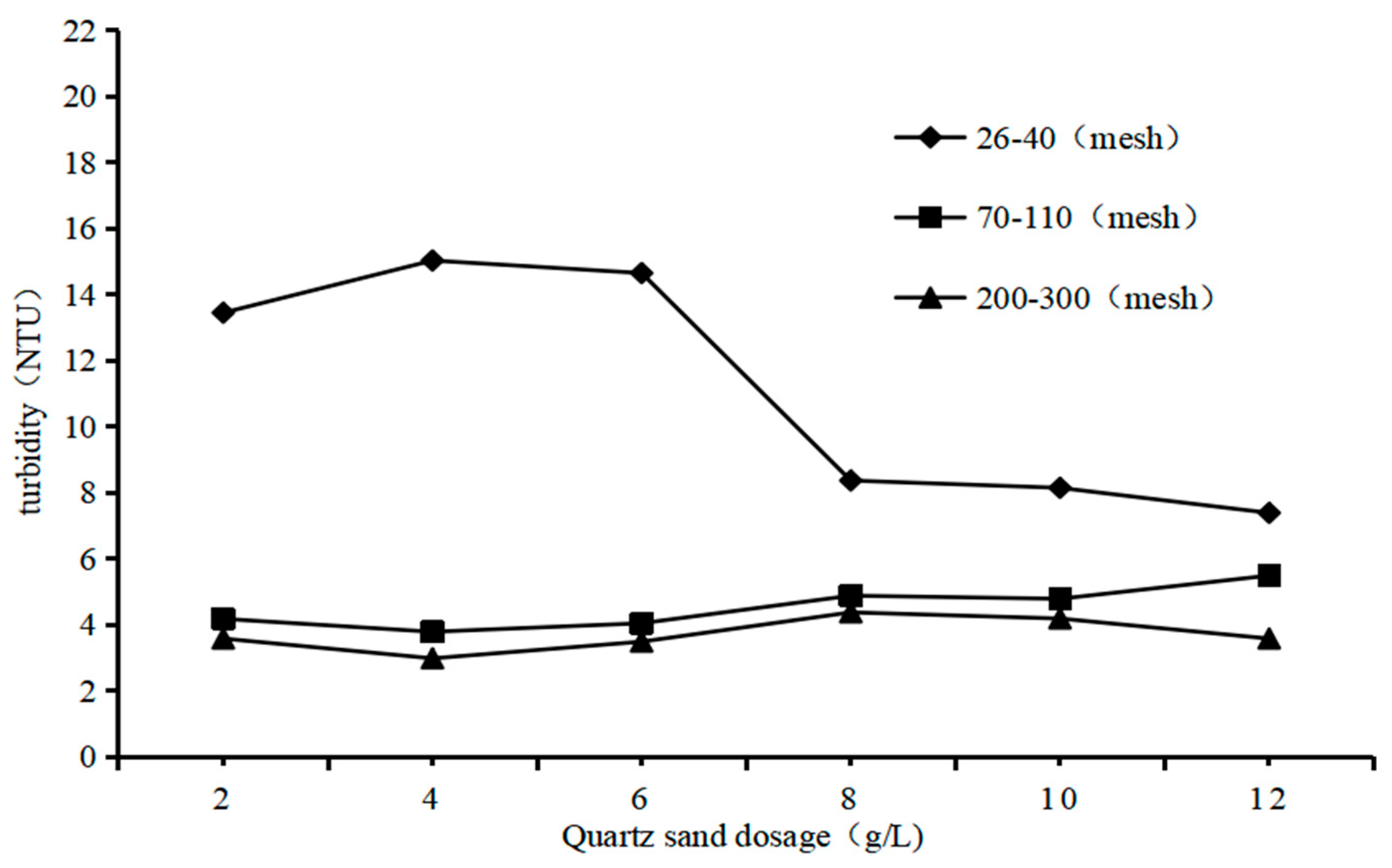
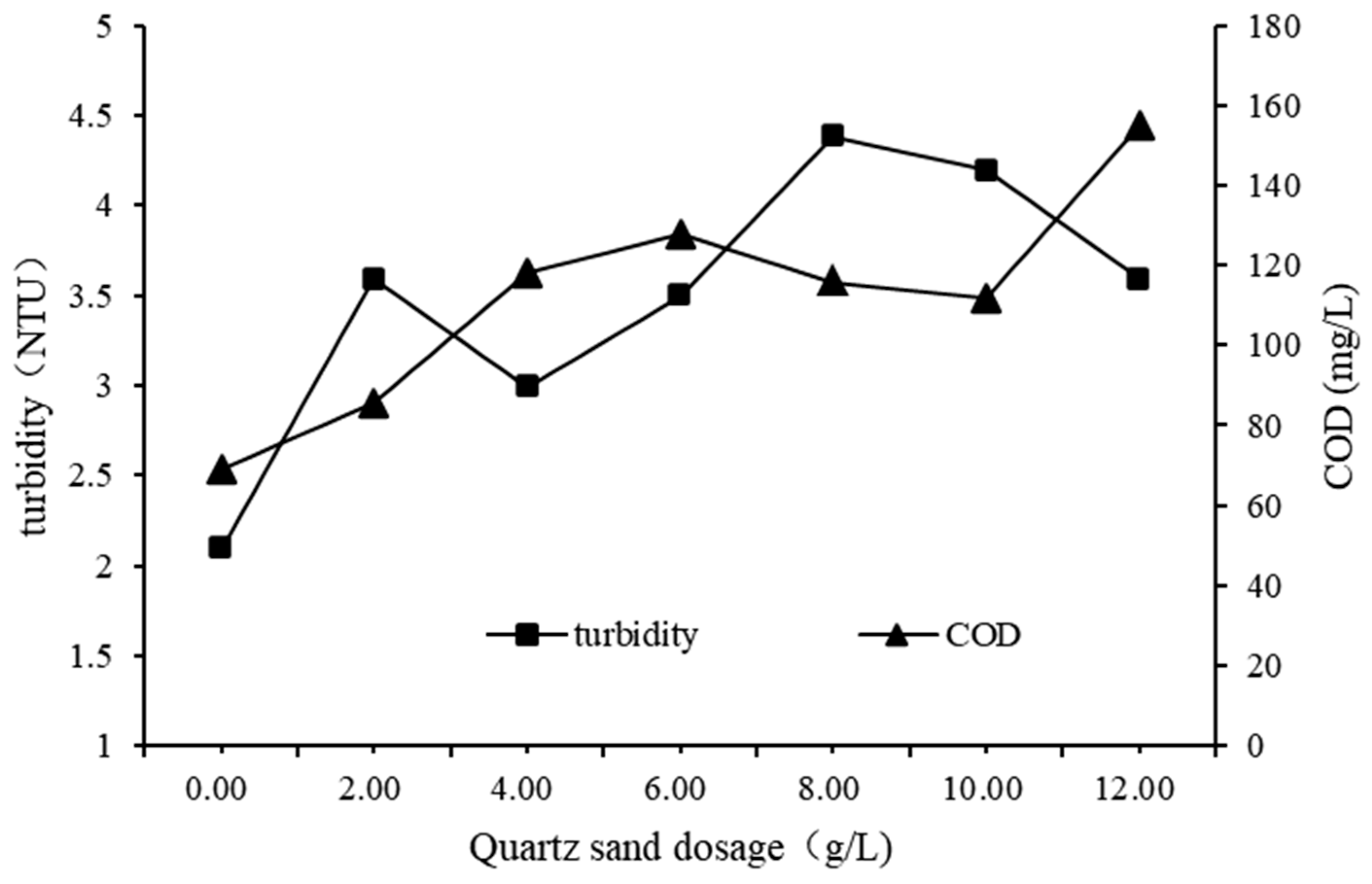
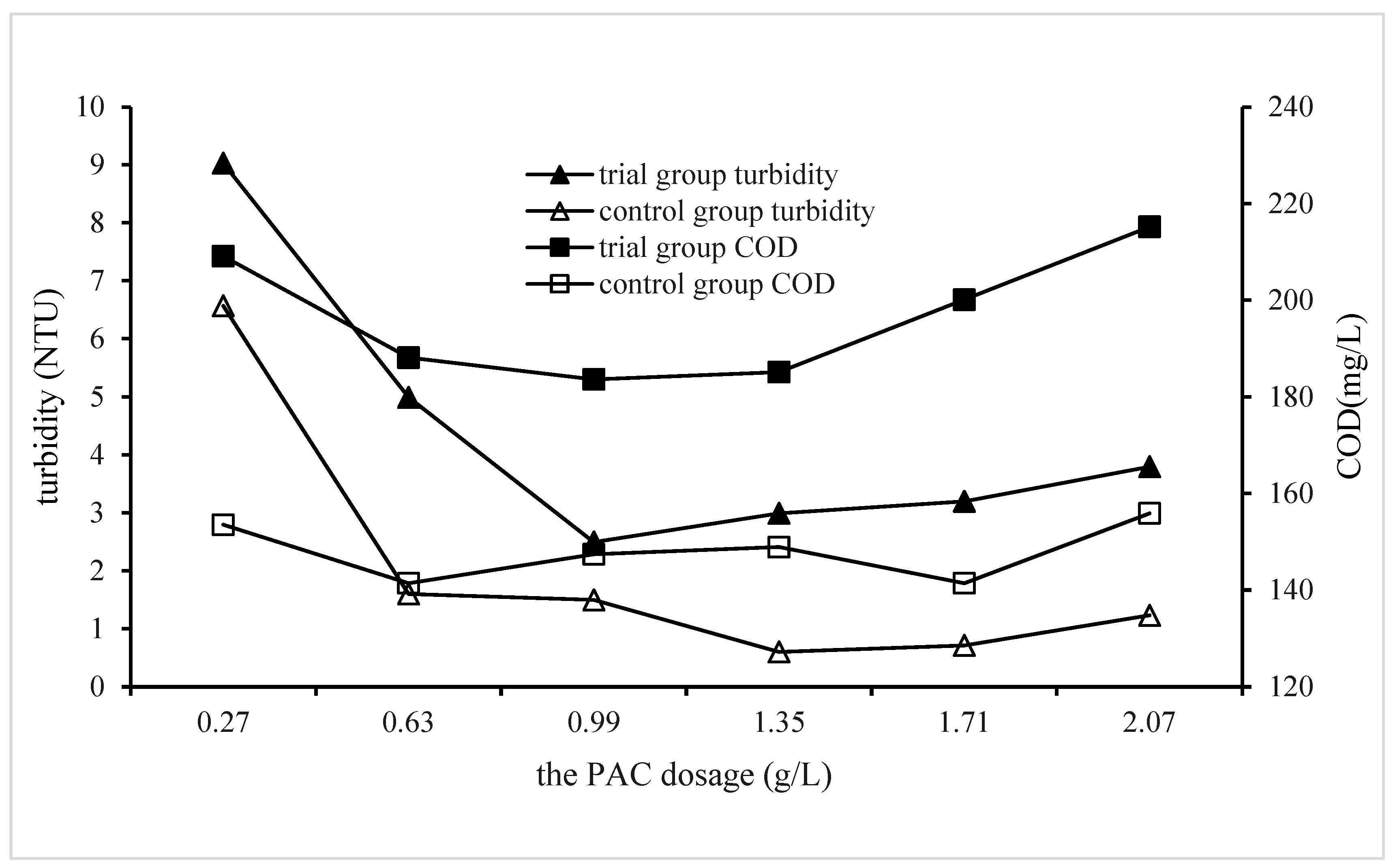


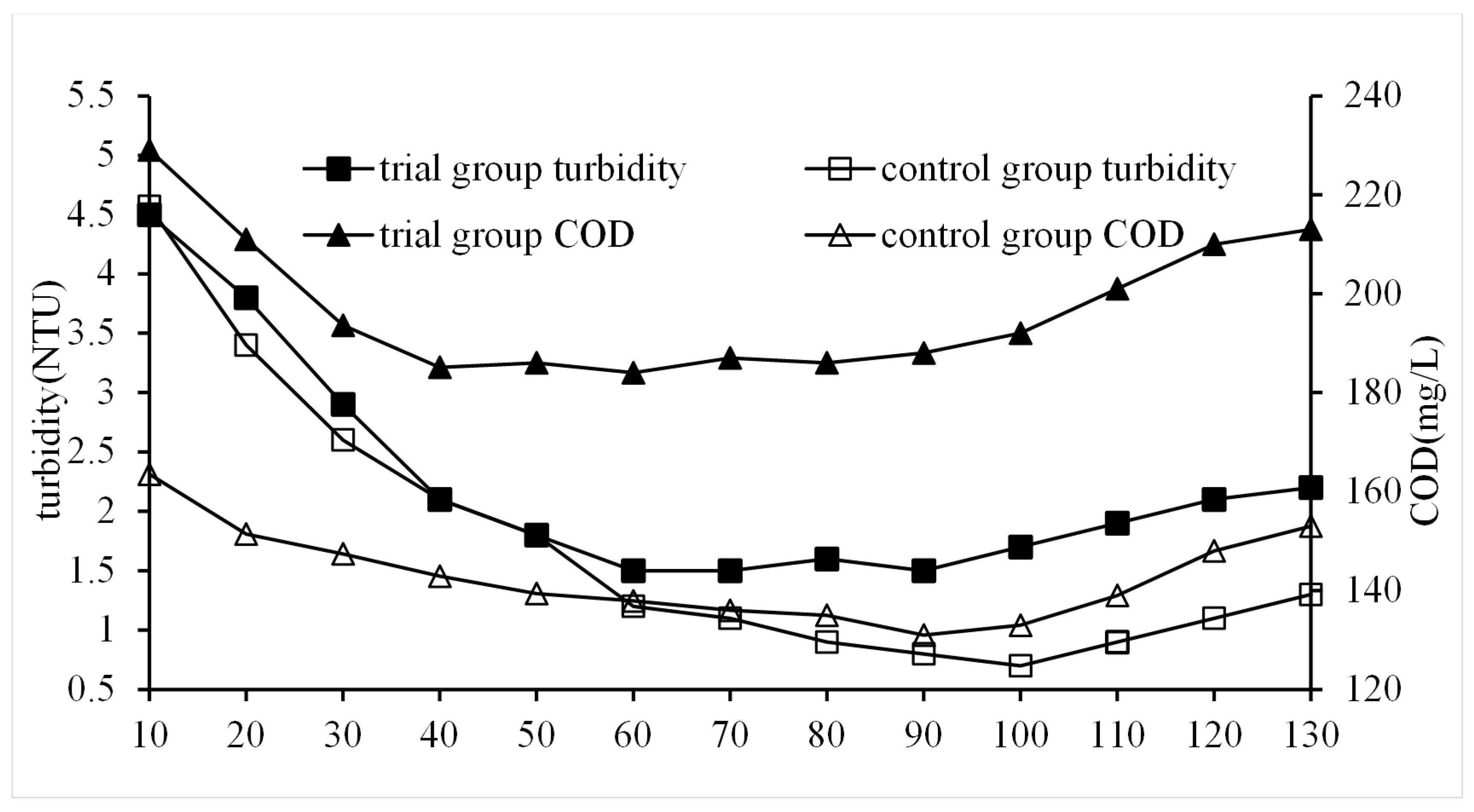
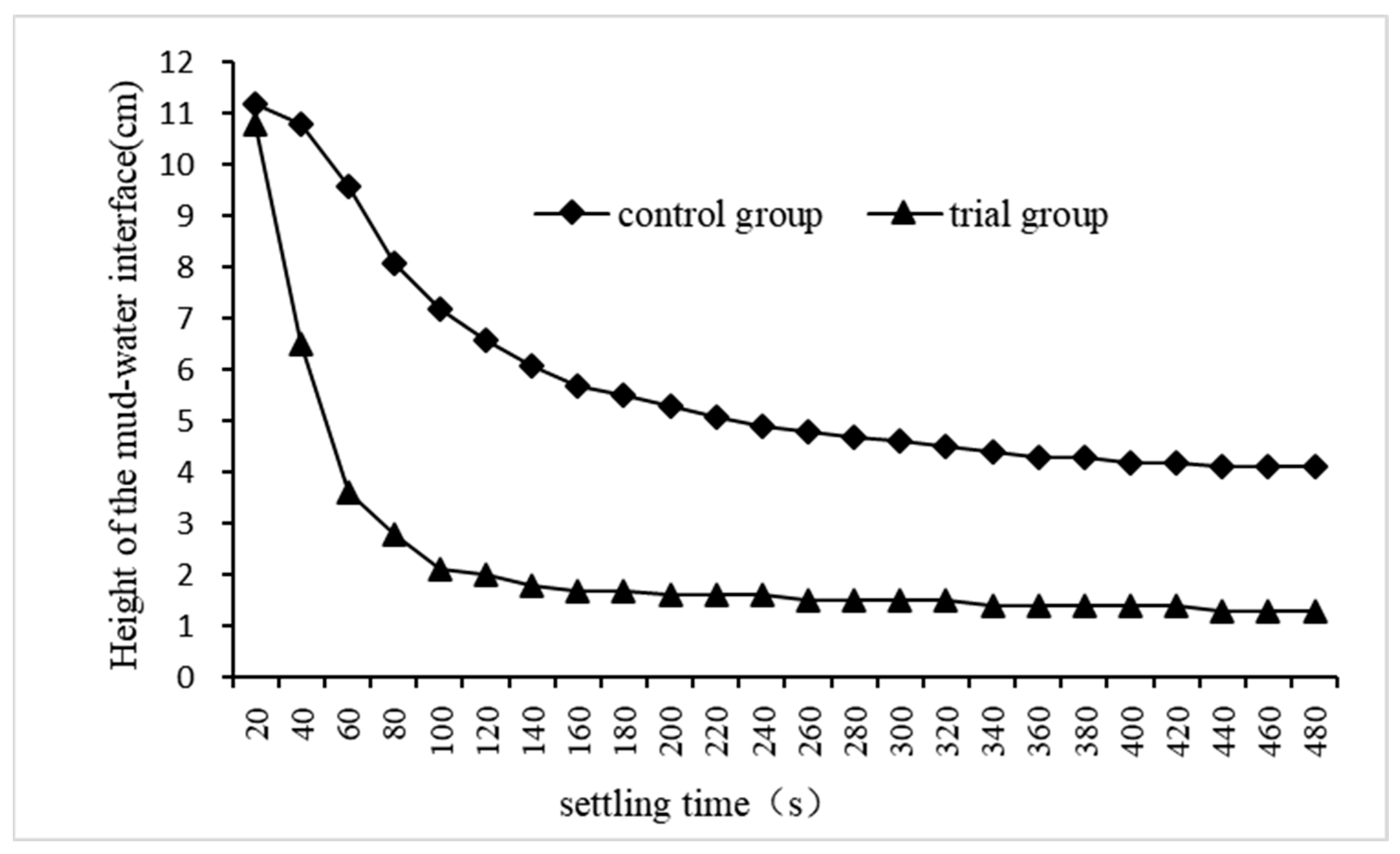


| Variable Code | Variables | Variable Levels and Corresponding Values | ||
|---|---|---|---|---|
| −1 | 0 | 1 | ||
| Z1 | PAC dosage (g/L) | 0.63 | 0.99 | 1.35 |
| Z2 | CPAM dosage (mg/L) | 1.8 | 2.3 | 2.8 |
| Z3 | sewage pH | 6 | 7 | 8 |
| Run | The CPAM Dosage (mg/L) | The Sewage pH | The Stirring Time (min) | The Response Value of Turbidity (NTU) | ||
|---|---|---|---|---|---|---|
| Actual | Predicted | |||||
| Equation (2) | Equation (3) | |||||
| 1 | 0.99 | 2.3 | 7.0 | 1.21 | 1.20 | 1.20 |
| 2 | 0.63 | 2.3 | 6.0 | 4.60 | 4.68 | 4.68 |
| 3 | 0.99 | 1.8 | 6.0 | 4.69 | 4.68 | 4.68 |
| 4 | 0.99 | 2.3 | 7.0 | 1.09 | 1.20 | 1.20 |
| 5 | 0.63 | 2.3 | 8.0 | 3.31 | 3.33 | 3.33 |
| 6 | 1.35 | 2.8 | 7.0 | 3.68 | 3.68 | 3.68 |
| 7 | 0.99 | 2.3 | 7.0 | 1.20 | 1.20 | 1.20 |
| 8 | 1.35 | 2.3 | 8.0 | 3.49 | 3.58 | 3.58 |
| 9 | 1.35 | 2.3 | 6.0 | 5.09 | 4.93 | 4.93 |
| 10 | 0.99 | 2.8 | 8.0 | 3.62 | 3.63 | 3.63 |
| 11 | 0.63 | 2.8 | 7.0 | 4.19 | 4.08 | 4.08 |
| 12 | 0.99 | 1.8 | 8.0 | 3.02 | 2.88 | 2.88 |
| 13 | 1.35 | 1.8 | 7.0 | 3.89 | 4.03 | 4.03 |
| 14 | 0.63 | 1.8 | 7.0 | 3.11 | 3.13 | 3.13 |
| 15 | 0.99 | 2.8 | 6.0 | 4.38 | 4.53 | 4.53 |
| 16 | 0.99 | 2.3 | 7.0 | 1.21 | 1.20 | 1.20 |
| 17 | 0.99 | 2.3 | 7.0 | 1.31 | 1.20 | 1.20 |
| Source | Sum of Squares | Df | Mean Squares | F value | p-Value Prob > F | Remark | |
|---|---|---|---|---|---|---|---|
| Model | Equation (2) | 31.13 | 9 | 3.46 | 230.56 | <0.0001 | significant |
| Equation (3) | 31.1 | 8 | 3.89 | 243.95 | <0.0001 | significant | |
| Z1-the PAC dosage (g/L) | Equation (2) | 0.125 | 1 | 0.125 | 8.33 | 0.0234 | |
| Equation (3) | 0.125 | 1 | 0.125 | 7.84 | 0.0232 | ||
| Z2-the CPAM dosage (mg/L) | Equation (2) | 0.18 | 1 | 0.18 | 12 | 0.0105 | |
| Equation (3) | 0.18 | 1 | 0.18 | 11.29 | 0.0099 | ||
| Z3-the sewage pH | Equation (2) | 3.64 | 1 | 3.64 | 243 | <0.0001 | |
| Equation (3) | 3.64 | 1 | 3.64 | 228.71 | <0.0001 | ||
| Z12 | Equation (2) | 0.4225 | 1 | 0.4225 | 28.17 | 0.0011 | |
| Equation (3) | 0.4225 | 1 | 0.4225 | 26.51 | 0.0009 | ||
| Z13 | Equation (2) | 0.0225 | 1 | 0.0225 | 1.5 | 0.2603 | |
| Equation (3) | ----- | ----- | ----- | ----- | ----- | ||
| Z23 | Equation (2) | 0.2025 | 1 | 0.2025 | 13.5 | 0.0079 | |
| Equation (3) | 0.2025 | 1 | 0.2025 | 12.71 | 0.0074 | ||
| Z12 | Equation (2) | 7.82 | 1 | 7.82 | 521.1 | <0.0001 | |
| Equation (3) | 7.82 | 1 | 7.82 | 490.44 | <0.0001 | ||
| Z22 | Equation (2) | 5.69 | 1 | 5.69 | 379.34 | <0.0001 | |
| Equation (3) | 5.69 | 1 | 5.69 | 357.03 | <0.0001 | ||
| Z32 | Equation (2) | 10.28 | 1 | 10.28 | 685.31 | <0.0001 | |
| Equation (3) | 10.28 | 1 | 10.28 | 644.99 | <0.0001 | ||
| Residual | Equation (2) | 0.105 | 7 | 0.015 | |||
| Equation (3) | 0.1275 | 8 | 0.0159 | ||||
| Lack of Fit | Equation (2) | 0.085 | 3 | 0.0283 | 5.67 | 0.0635 | not significant |
| Equation (3) | 0.1075 | 4 | 0.0269 | 5.38 | 0.0661 | not significant | |
| Pure Error | Equation (2) | 0.02 | 4 | 0.005 | |||
| Equation (3) | 0.02 | 4 | 0.005 | ||||
| Cor Total | Equation (2) | 31.23 | 16 | ||||
| Equation (3) | 31.23 | 16 | |||||
| R2Pre | Equation (2) | 0.9555 | |||||
| Equation (3) | 0.9603 | ||||||
| R2adj | Equation (2) | 0.9923 | |||||
| Equation (3) | 0.9918 | ||||||
| Coagulation Conditions | Sewage Turbidity (NTU) | ||||||
|---|---|---|---|---|---|---|---|
| PAC Dosage (g/L) | CPAM Dosage (mg/L) | Sewage pH | Quartz Sand Dosage (g/L) | Stirring Time (min) | Settling Time (min) | Average of Measured Value | Predicted Value |
| 0.97 | 2.25 | 7.22 | 2 | 5 | 30 | 1.15 | 1.11 |
Disclaimer/Publisher’s Note: The statements, opinions and data contained in all publications are solely those of the individual author(s) and contributor(s) and not of MDPI and/or the editor(s). MDPI and/or the editor(s) disclaim responsibility for any injury to people or property resulting from any ideas, methods, instructions or products referred to in the content. |
© 2024 by the authors. Licensee MDPI, Basel, Switzerland. This article is an open access article distributed under the terms and conditions of the Creative Commons Attribution (CC BY) license (https://creativecommons.org/licenses/by/4.0/).
Share and Cite
Zhang, Z.; Li, Y.; Liu, Y.; Li, Y.; Wang, Z.; Wang, D.; Yan, L.; Zhao, J.; Li, B.L. Optimization of Quartz Sand-Enhanced Coagulation for Sewage Treatment by Response Surface Methodology. Materials 2024, 17, 3482. https://doi.org/10.3390/ma17143482
Zhang Z, Li Y, Liu Y, Li Y, Wang Z, Wang D, Yan L, Zhao J, Li BL. Optimization of Quartz Sand-Enhanced Coagulation for Sewage Treatment by Response Surface Methodology. Materials. 2024; 17(14):3482. https://doi.org/10.3390/ma17143482
Chicago/Turabian StyleZhang, Zhengan, Yepu Li, Yongzhi Liu, Yuying Li, Zonghua Wang, Dayang Wang, Lu Yan, Jiayin Zhao, and Bailian Larry Li. 2024. "Optimization of Quartz Sand-Enhanced Coagulation for Sewage Treatment by Response Surface Methodology" Materials 17, no. 14: 3482. https://doi.org/10.3390/ma17143482






